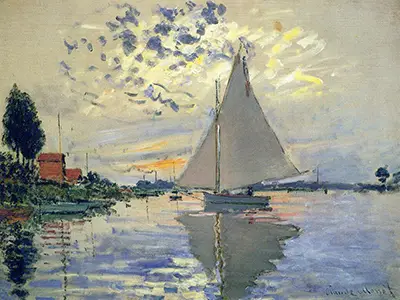His Sailboat painting does not fail to please. It is rich with the masterful use of colour that creates a pleasing scene of a boat, the sea and the warm sky.
Monet has always worked well with light in his paintings and the reflections in the water are a testament to his skill. The boat is positioned in the centre of the painting, with the land on the left reminding viewers of what was left behind even as the open water beckons to the right.
The painter's theme was one that commonly captivated artists in France. Paddling and cruising were a popular pastime so there were ample opportunities for Impressionists like Monet and Renoir to paint scenes that everyone could connect with.
In one Impressionist painting, a couple, wearing what you may call their Sunday-trip best, remain on the green bank of the sparkling Seine River. This is the scene portrayed in "Rowers at Chatou," which the Impressionist craftsman Pierre Auguste Renoir painted in the later 1870s. It is presently on view at the Peabody Essex Museum.
Monet's Sailboat leaves viewers to imagine those who enjoyed their trip but it is just as pleasing. In Renoir's painting the man and lady are to be paddled about in a long exquisite wooden gig. Out of sight are a sailboat, a stream freight boat and men paddling sculls. With the Impressionists, boats were the embodiment of a languid, summer occasion. Paintings like "Sailboat" provided a look into that feeling of relaxation that comes from recreation.
These nineteenth century compositions are modern in their theme. Previous French painting had concentrated on myth, history and nobles. The Impressionists portrayed an ascendant white collar class. They painted the activities of those who came out of the Revolution. The new manufacturing plants cultivated the advancement of French railroads and started new tourism along beautiful angling towns like Chatou.
These mainstream recreational joys turned into a focal subject for Monet and other Impressionists. Their vivid paintings showed individuals unwinding in parks and gardens, along waterways, at shorelines and in the lamplight of theatres. They show an aspect of Parisian culture which was new then and still exists in the present day.
These are ideas we still profoundly relate to and that is what helps to make Monet's "Sailboat" so interesting. It captures the feeling of freedom that comes with not being obligated to go to work or even to a scheduled rugby or netball match. Viewers cherish the Impressionists' present day theme of time off.
Amid the Franco-Prussian War Monet was in London. Upon his arrival in 1871 he moved with his family to Argenteuil. A beautiful, memorable town and a thriving suburb, Argenteuil was only 15 minutes from Paris. In the late nineteenth century it was unrivaled for Sunday excursions and boat trips. This move turned out to be profitable for Monet in several ways and he completed several beautiful paintings of boats and outdoor life while living there.
Monet gained a vessel, which he transformed into a gliding studio. The River Seine and its cruising water crafts turned into the main topic of his depictions. In some paintings, the town of Argenteuil may be witnessed not too far off. Light and its impact on the water's surface are readily considered as Monet displays the skill that he is admired for.
While Monet effectively accurately described life in a large number of his works, his point was to dissect the constantly changing nature of shading and light. Known as the exemplary Impressionist, one cannot help but have profound esteem for his artistic ability. "Sailboat" has an insurmountable magnificence.
Over the years Sisley, Renoir and Pissarro all joined Monet to paint in Argenteuil and the towns close by. As the once provincial zones turned out to be progressively available by rail, they got to be distinctly prominent for Parisians. These youthful French Impressionists, devoted to painting contemporary urban common life, were pulled in by this engaging blend of the conventional holiday scene and the innovations of the Industrial Revolution.


